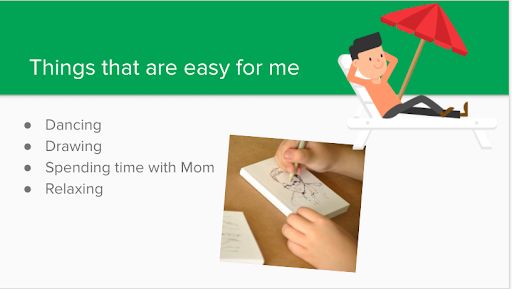AAC in Secondary School: Centering AAC Users in the IEP Process
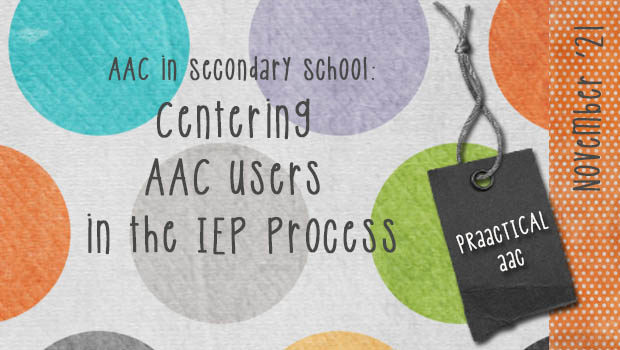
 In theory, teenage students with disabilities should play an important role in developing their IEPs and in meetings to discuss them. In practice, this rarely occurs. Today, we’re addressing this important topic with another post in our series focusing on supporting students using AAC during their high school years.
In theory, teenage students with disabilities should play an important role in developing their IEPs and in meetings to discuss them. In practice, this rarely occurs. Today, we’re addressing this important topic with another post in our series focusing on supporting students using AAC during their high school years.
AAC SLP Ashley Larisey, an SLP at Community High School District 218 in Oak Lawn, Illinois, is here to discuss ways to support students who use AAC as they prepare to transition out of school. Ashley, who is also an Adjunct Clinical Supervisor and Instructor at Saint Xavier University, has some prAACtical suggestions that are important for school teams, students who use AAC, their families, and school administration.
:::::::::::::::::::::::::::::::::::::::::::::::::::::::::::::::::::::::::::::::::::::::::::::::::::::::
Centering AAC Users in the IEP Process
When supporting older students who use AAC and are quickly approaching adulthood, our Individualized Education Plans (IEPs), goal development, services, and progress monitoring will shift to address future planning. Much of this is addressed within the transition plan, which becomes part of the IEP at age 14 or earlier in the United States (see Transition, Transition Services, and Transition Planning on Wrightslaw for more information). Before we jump into some actionable ways to involve students in the IEP process, let’s review the definitions these terms:
Person-Centered Planning: “Person-Centered Planning is an ongoing problem-solving process used to help people with disabilities plan for their future. In person-centered planning, groups of people focus on an individual and that person’s vision of what they would like to do in the future.” (Pacer, 2019)
Self-Determination: “Self-determination is believing you can control your own destiny. Self-determination is a combination of attitudes and abilities that lead people to set goals for themselves, and to take the initiative to reach these goals.” (Pacer, 2019)
Person-centered planning and self-determination are key components of the IEP process. Let’s review some of the ways you can involve your students within the process in the development of their IEP.
Student Interviews: The use of student interviews help to center the learner in the IEP planning process. Interviews provide guidance for team members in formulating meaningful goals and providing access to opportunities to help students achieve those goals. Interviews and surveys are frequently used as part of the transition planning process – here are a few options:
- The Framing a Future Tool (King, Lunger, & Toomey – The Bridge School ©2005) is one example of a survey that can be used to develop person centered goals. The survey is framed around seven major life areas (Community Membership, Control of Personal Health & Welfare, Pursuit of Lifelong Learning, Developing Talents & Interests, Creating Healthy Relationships, Self-Reliance, & Developing a Personal Sense of Spirituality) that are reviewed across four different stages. Determining what this new environment will look like based on what is important to the AAC user is just one piece of supporting a successful transition focused on self-determination.
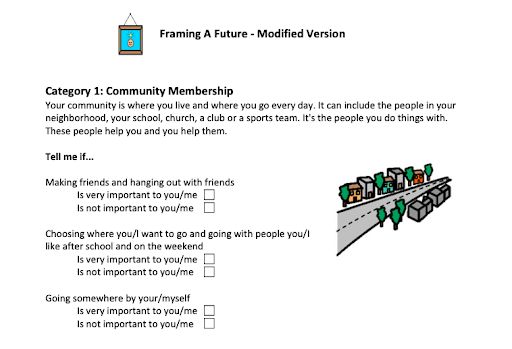
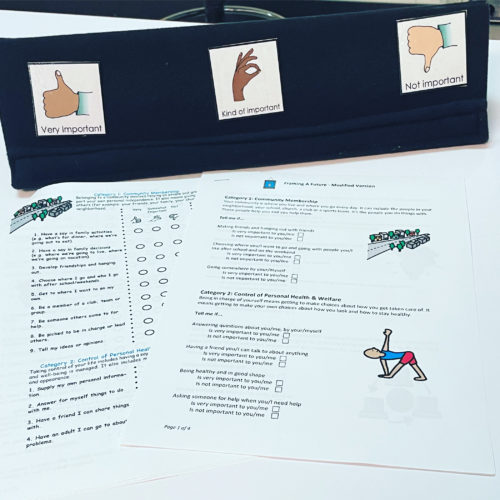
Examples taken from the Framing a Future Tool
- The Self-Determination Inventory is a tool used to help guide students and teams in knowing where students are at in the process of self-determination. The inventory looks at Volitional Action (deciding what to do), Agentic Action (acting to move closer toward a goal), and Action-Control Beliefs (belief that a goal can be achieved). The Student Report Guide helps to outline the meaning of the inventory and potential goals to help students grow in their own self-determination.
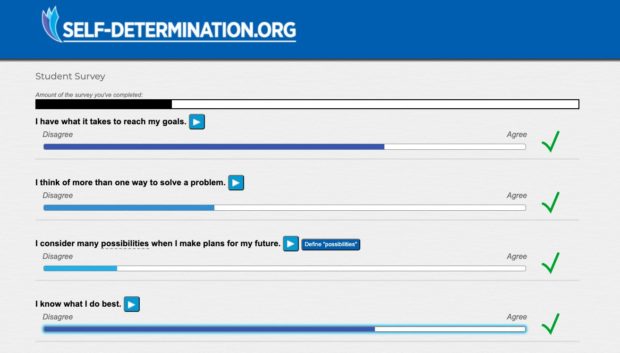
Sample pages from the Self-Determination Inventory
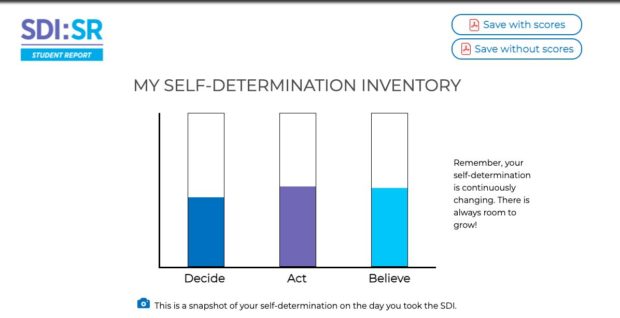
Sample pages from the Self-Determination Inventory
- Talking Mats can be useful for students who benefit from visual supports to aid comprehension and expression. Talking Mats focus on one topic per session with 10-20 options related to each topic. Visual rating scales are used (e.g. like/not like, want/don’t want, important/not important) to rate the options using open-ended questions. As individuals become more familiar with the process using personal interests (e.g. TV shows), different topics are introduced that help the individual exercise choice and preferences in future planning.
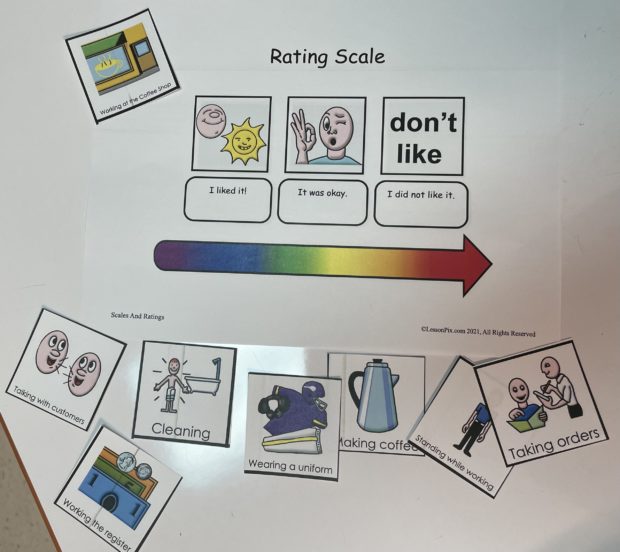
Sample Talking Mats Activity for Coffee Shop job duties (created with LessonPix)
Preparing and Sharing at the IEP Meeting: Bringing students into the IEP preparation process can be a meaningful opportunity for students to plan what information they want to bring to the IEP meeting. Here are some ideas for ways to support students in preparing for their IEP meeting.
- Create custom slideshow presentations with your students to guide the IEP meeting. Using a slideshow helps to provide all team members with a visual representation of the students day, activities, ways in which they learn best, useful learning strategies, and future goals. This can also be beneficial for students who are not yet able to talk about their day with their families. By providing examples, photos, and activities that are important to the learner, all stakeholders have important information about the student that can facilitate conversation and strengthen relationships. Here is a slideshow template that can be co-constructed with students in preparation for their meeting. These can be personalized with student photos, images, and GIFs in collaboration with the student prior to the meeting.
- Create a collage or poster: Include examples of student strengths, future goals, important people, and any other information to capture what the student is doing right now and what their future goals and plans are.
- Prepare a speech for the IEP meeting: As much as possible, involve the student and try to ensure they are able to attend the meeting and provide their own contributions. Provide student choices on what they would like to share and how they would like to share it. By preparing information in advance, students can compose, practice, and edit speeches to add relevant information. This can be done using prestored messages within a robust AAC system, using sequential single message voice output devices, or even added into the slideshow presentation as embedded audio.
Share your ideas – how do you involve AAC users in the IEP process?
Filed under: Featured Posts, PrAACtical Thinking
This post was written by Carole Zangari
